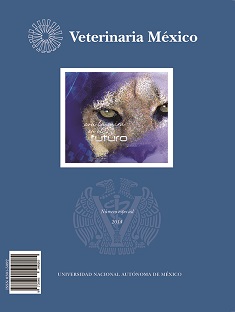Transmission of Brucella abortus to female calves younger than three months of age, diagnosed by the card and radial immunodiffusion tests in two dairy herds in the state of Queretaro, Mexico
Main Article Content
Abstract
Article Details
References
Flores CR. Bases científicas en el uso de vacunas contra la brucelosis. Memorias del 4º Curso internacional de medicina productiva en bovinos lecheros; 2010 abril 22-24; Juriquilla (Querétaro) México (DF): Universidad Nacional Autónoma de México, 2010:85-90.
OIE, College of Veterinary Medicine Iowa State University-The Center Food Security & Public Health 2009. Brucellosis. Serial online: año mes] [Cited: 2011 February 10]. Available from: http://www.cfsph.iastate. edu/Factsheets/es/brucelosis.pdf.
Herrera E, Palomares G, Díaz AE. Milk production increase in a dairy farm under a six-year brucellosis control program. Ann N Y Acad Sci 2008; 1149:296 –299.
López MA, Pérez MAE. Seroepidemiology of brucellosis in Mexico. Salud Pública de México 1992; 34:230-240.
Radostits OM, Blood DC, Gay CC. Veterinary Medicine. 10th ed. London: Balliere Tindall, 2007.
Enright FM, Nielsen K, Duncan JR. The pathogenesis and pathobiology of Brucella infection in domestic animals. Boca Raton (FL): CRC Press, 1990.
Crawford RP, Adams LG, Ficht TA, Templeton JW, Williams JD. Effects of stage of gestation and breed on bovine responses to vaccination with Brucella abortus strain 19. J Am Vet Med Assoc 1991; 199:887–891.
Cheville NF, Mccullough DR, Paulson LR. Brucellosis in the Greater Yellowstone Area. Washington, DC: National Research Council; 1998:25.
Olsen S, Tatum F. Bovine brucellosis. Vet Clin Food Anim Pract 2010; 26:15-27
Bickett WD, Trevino I. Biological risk management, an overview. 2010. Memorias del 4º Curso internacional de medicina productiva en bovinos lecheros; 2010 abril 22-24; Juriquilla (Querétaro) México (DF): Universidad Nacional Autónoma de México, 2010:5-13.
Olsen SC, Thoen CO, Cheville NF, Gyles CL, Thoen CO, Prescott JF et al. Brucella. Pathogenesis of bacterial infections of animals. Ames (IA): Blackwell Publishing, 2004.
Roop RM, Gee JM, Robertson GT, Richardson JM, NG WL, Winkler ME. Brucella stationary-phase gene expression and virulence. Annu Rev Microbiol 2003; 57:57–76.
Bustamante SJ, Salazar HF, Díaz AE, Manzano CC, Pérez GR, Hernández AL. Estudio bacteriológico y serológico de brucelosis en vacas revacunadas con dosis reducida de cepa 19 de Brucella abortus. Téc Pec Méx. 2000; 38:35-42.
Aparicio BA, Díaz AE, Hernández AL, Pérez GR, Alfonseca SE, Suarez GF. Serological and bacteriological evaluation of a bovine herd infected with brucellosis and revaccinated with a reduced dose of Brucella abortus strain 19. Téc Pec Méx 2003; 41(2):129-140.
DOF. “Campaña Nacional contra la Brucelosis en los Animales” Norma Oficial Mexicana NOM-041- ZOO-1995. Diario Oficial de la Federación 20 agosto 1996.
Díaz AE, Hernández AL, Valero EG. Diagnóstico de brucelosis animal. México: Instituto Nacional de Investigaciones Forestales, Agrícolas y Pecuarias, 2001.
Alton GG, Jones LM, Angus RD. Techniques for the brucellosis laboratory. Paris: Institute National de la recherché e agronomique; 1988.
Sambrook J, Fritsch EF, Maniatis T. Molecular cloning. Laboratory manual. 2nd ed. New York: Cold Spring Harbor Laboratory Press, 1989.
Sangari FJ, Garcia-Lobo JM, Aguero J. The Brucella abortus vaccine strain B19 carries a deletion in the erythritol catabolic genes. FEMS Microbiol Lett 1994b Sep 1;121(3):337-42.
Vemulapalli R, Mcquiston JR, Schurig GG, Sriranganathan N, Halling SM, Boyle SM. Identification of an IS711 element interrupting the wboA gene of Brucella abortus vaccine strain RB51 and a PCR assay to distinguish strain RB51 from other Brucella species and strains. Clin Diagn Lab Immunol1999 Sep;6(5):760-4.
License

Veterinaria México OA by Facultad de Medicina Veterinaria y Zootecnia - Universidad Nacional Autónoma de México is licensed under a Creative Commons Attribution 4.0 International Licence.
Based on a work at http://www.revistas.unam.mx
- All articles in Veterinaria México OA re published under the Creative Commons Attribution 4.0 Unported (CC-BY 4.0). With this license, authors retain copyright but allow any user to share, copy, distribute, transmit, adapt and make commercial use of the work, without needing to provide additional permission as long as appropriate attribution is made to the original author or source.
- By using this license, all Veterinaria México OAarticles meet or exceed all funder and institutional requirements for being considered Open Access.
- Authors cannot use copyrighted material within their article unless that material has also been made available under a similarly liberal license.



